KELT-6b Co-discovery
2013-06-04 – I'm proud to annouce the co-discovery of KELT-6b, a saturn-like exoplanet in a collaboration as a member of the KELT Follow-up Team. This is my first Kelt c-discovery but my third exoplanet discovery.
Karen Collins made the pre-announcement of this discovery at 222nd AAS meeting in Indianapolis.
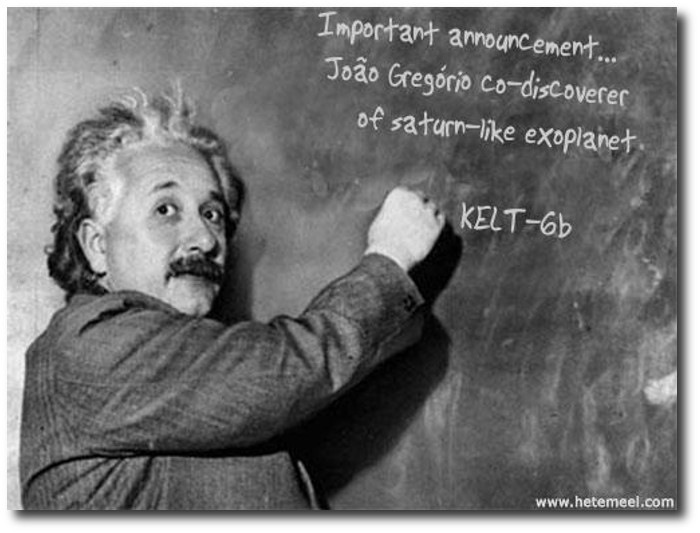
KELT-6b: A Transiting Mildly-Inflated Saturn with a Metal-Poor Host, 222nd Meeting of the American Astronomical Society, Indianapolis, IN, June 1-6, 2013.
Collins, K. A., Siverd, R., Beatty, T. G., Eastman, J., Gaudi, B. S., Pepper, J., Stassun, K., Latham, D. W., Bieryla, A., Manner, M., Jensen, E. L., Kielkopf, J. F., Gregorio, J., Fulton, B. J., Buchhave, L. A., Penev, K., Crepp, J. R., Cargile, P., Mack, C. E., Oberst, T. E., Avril, R. L., Mellon, S., McLeod, K. K., Dhital, S., Stefanik, R. P., Calkins, M. L., Esquerdo, G., Berlind, P. L., Street, R., Zambelli, R., Mao, Q., Richert, A. J., Gould, A., Depoy, D. L., Marshall, J. L., Pogge, R. W., Trueblood, M., Trueblood. P.,
Abstract: We present the discovery of KELT-6b, a mildly inflated transiting Saturn, orbiting a metal-poor star. A joint analysis of the spectroscopic, radial velocity, and photometric data indicates the planet has a mass of 0.5 M_J, radius of 1.3 R_J, and an orbital period of ~8 days. The bright (V~10) host is a slightly evolved, metal-poor F star with [Fe/H]~-0.3 and an inferred mass and radius of ~1.2 M_sol and ~1.7 R_sol. Although KELT-6 is more evolved than HD209458, the orbital period of KELT-6b is longer than HD209458b, resulting in almost identical incident flux at both planets. Thus, KELT-6b is a metal-poor twin of HD209458b, one of the best understood exoplanets, and offers the unique opportunity to perform a comparative measurement of two similar planets in similar environments around stars of very different metallicities in order to test theories of exoplanetary atmospheres, in particular the causes of atmospheric temperature inversions, and to test theories of planet formation. High resolution radial velocity data indicate a possible longer period third body in the system. No companions are detected in Keck adaptive optics imagery, allowing constraints on the mass and period of the putative companion.
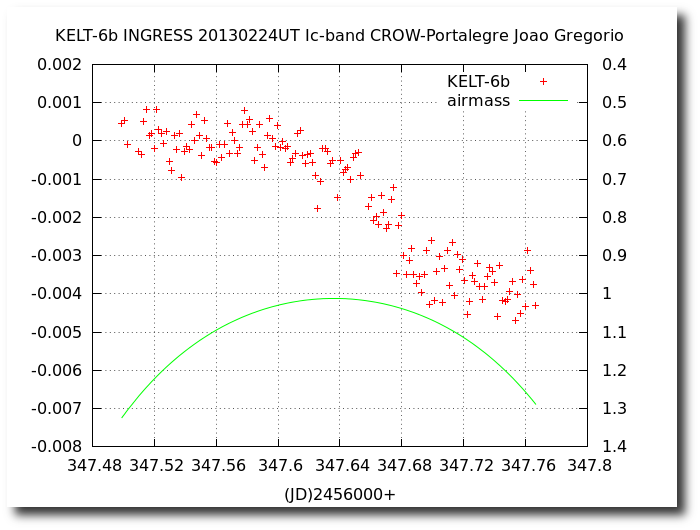
Above is the lightcurve of the exoplanet Ingress. This is a partial of the 5h long tansit captured with the 12" SCT @CROW-obs. Portalegre.
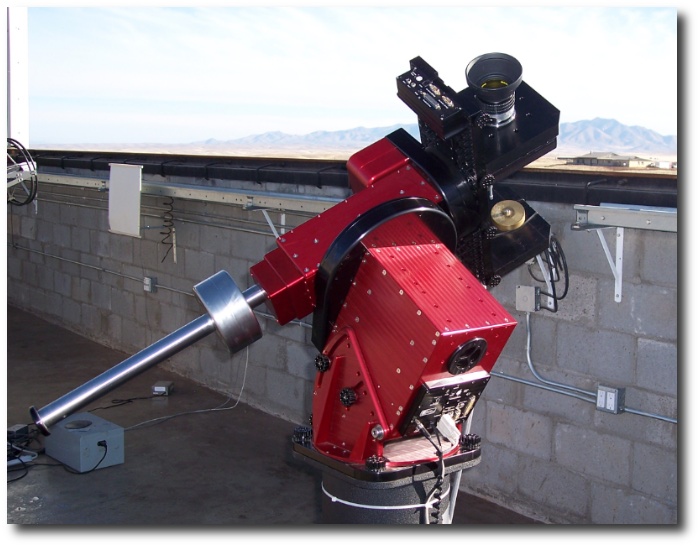
Kilodegree Extremely Little Telescope at WINER Observatory in Arizona, USA (c)J.Pepper
This small "telescope" in the image is the KELT-North survey telescope located in Arizona.
The telescope is in fact a photographic 80mm F1.9 objective with an astronomy-camera capturing a 26º field of view.
It's purpose is to generate a list of candidates to be checked by the Follow-up Team and search for "true" transiting events.
I've started my collaboration with KELT in July 2012 after an invitation to join the Follow-Up Team made by Dr. Joshua Pepper.
The discovery started with an observation of the candidate star made by Karen Collins in June 2012 who detected a transit like ingress feature.
After the alert we tried to observe this candidate as much we can, because of his period we don't get much opportunities to aim at it and collect data. After a few observations the candidate was looking very promising and when confirmation came from radial velocity Karen, principal investigator for this target, started to draft the discovery paper she presented at the 222nd AAS meeting.
I manage to do a couple observations of this target located in the Coma Berenices constellation orbiting a magnitude V10 star with a period of ~8days and give my contribute to the discovery.
I used my 12" telescope to do the observations. It's a Meade SCT LX200 striped of the fork and mounted on a Losmandy G11. The Camera is a SBIG ST-10XE the one used to capture the observation above. Usually I use a SBIG ST-8XME with photometric filters V, Rc, Ic from Custom Scientific. My big thanks to Placido Inocentes for borough the Telescope and camera(s)
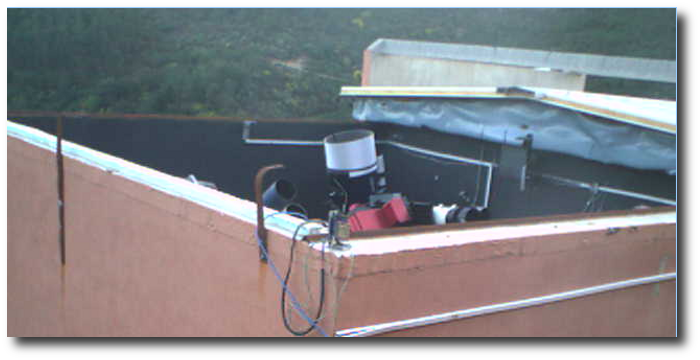
12" SCT waiting for the right moment to capture SkyFlats.
I'm grateful to José Canela for the opportunity to use a corner at his remote observatory in Portalegre-Portugal. From the comfort of home I can plan and observe while I'm doing other things… like sleep 🙂
From aiming, focusing, capturing the planned session, collect calibration frames and close at the end of the session it does it all by itself.
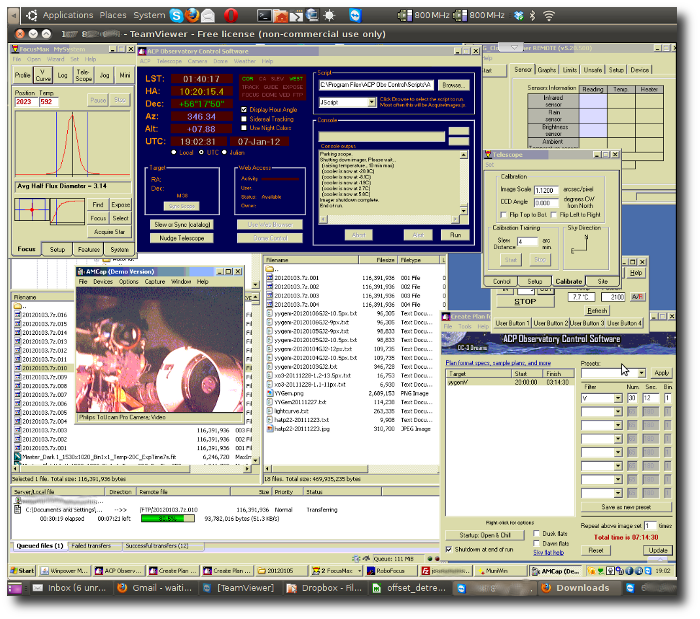
Screen shot of what my remote operation looks like
This is what looks like my remote compute rwith all the programs to control and command the equipment via internet at 240 km away.
Thanks to all of the KELT-north Team members and also Canela and Placido.
Joao Gregorio
